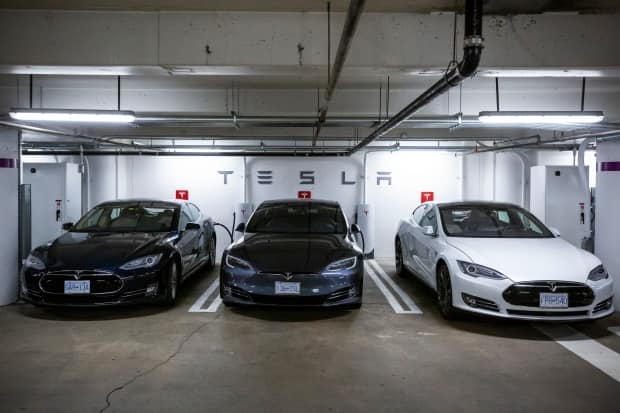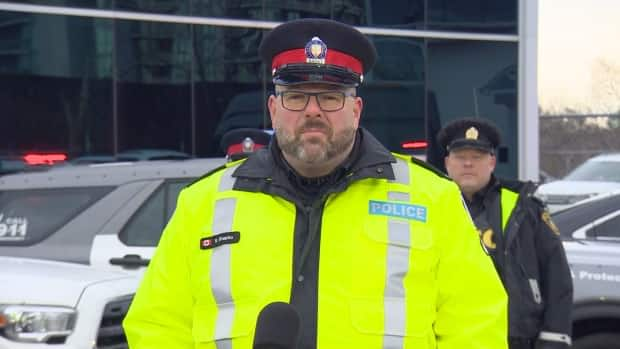Toronto Tesla owners can now use self-driving mode downtown. But safety experts are worried

Tesla drivers can finally use the vehicles' self-driving feature in Toronto's downtown core after Elon Musk's company removed a digital barrier to the technology this week.
Tesla had blocked the use of its Full Self-Driving (FSD) software south of Bloor-Danforth back in March, reportedly due to the difficulty FSD had with TTC streetcars stopping and letting off passengers in the middle of the street.
"The official answer we got from Elon Musk was streetcars," Chansoo Byeon told CBC News after the Tesla enthusiast received a personal answer from the company's CEO himself on Twitter.
CBC Toronto has tried and failed on several occasions to get an explanation from Tesla about how the software update solves the streetcar problem. But now that FSD is no longer blocked, some critics are concerned about road safety in Toronto's downtown core.
"I think there's a significant risk until we have a broader understanding of how this algorithm works," said Brian Patterson, president and CEO of the Ontario Safety League.
He says the move is dangerous for a number of reasons, not just because of streetcars. He also points to traffic congestion, construction zones, pedestrians and "less-than-stellar" drivers.

Patterson says the City of Toronto should speak to the province about the potential issues raised by driverless vehicles operating downtown.
The Ontario Ministry of Transportation, which regulates automated driving in the province, would not comment on whether Tesla explained the fix or consulted with the province before making the decision.
In a statement sent to CBC Toronto Thursday, TTC spokesperson Stuart Green said the agency reached out to Tesla many months ago to get clarity on the situation, but received no response — and "no heads up on this move," either.
"I will say that TTC operators are trained to navigate the roads of Toronto safely, being mindful of pedestrians, cyclists and other motorized vehicles, including Teslas," Green said. "We would hope, and assume, Elon Musk and his programmers have the same regard for the safety of Torontonians.
"This would mean ensuring their FSD technology recognizes streetcars stopped with their doors open."
Teslas aren't really driverless, police officer warns
Const. Sean Shapiro, who works with the traffic services division of the Toronto Police Service, says Tesla nevertheless has the authority to make the change without the province.
"It was already legal in Ontario," he said.
However, Shapiro warns Tesla drivers can't just sit back, relax and scroll on their smartphones while self-drive mode is in effect.
He says there are six levels of autonomy (0 to 5) in vehicles and Tesla's FSD falls under level three (3), meaning the vehicle responds to its environment and can perform most driving functions, but still requires human override.

"It is ... very much something that requires the active participation of the supervising driver."
Because of this, Shapiro adds, someone sitting in the driver's seat of a car in self-driving mode is just as liable as someone driving a regular car.
"This isn't time to pull out your cell," said Shapiro, adding drivers could still be charged as if they were driving while using their phones.
Shapiro says he has seen widespread abuse of autonomous vehicles while on patrol.
"They're assuming that they are free to do other things," he said.
"You still have to be an active participant, and if you choose not to, you are putting your life and the life of others at risk."
Driverless technology getting better, says expert
Bilal Farooq, an expert on autonomous vehicles, says people should be "cautiously excited" about the advances in technology, as long as the industry is properly regulated.
Beta testing of Tesla's FSD was introduced in Canada last March. Farooq says drivers with safe records are given the opportunity to test and improve the technology, which he suggests is how Tesla arrived at a point where it could roll it out downtown.
"I guess now they feel comfortable introducing it and that's why we have it," said Farooq, an associate professor of engineering at Toronto Metropolitan University.
Farooq says there have been relatively few accidents reported involving driverless vehicles and pedestrians.
"I think the technology itself is maturing now in a much steadier way," he said.
"The focus should be on making sure that the regulations are there."

 Yahoo Finance
Yahoo Finance 